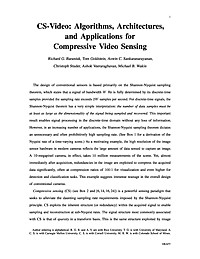
Algorithms, Architectures, and Applications for Compressive Video Sensing
The design of conventional sensors is based primarily on the Shannon-Nyquist sampling theorem, which states that a signal of bandwidth W Hz is fully determined by its discrete-time samples provided the sampling rate exceeds 2W samples per second. For discrete-time signals, the Shannon-Nyquist theorem has a very simple interpretation: the number of data samples must be at least as large as the dimensionality of the signal being sampled and recovered. This important result enables signal processing in the discrete-time domain without any loss of information. However, in an increasing number of applications, the Shannon-Nyquist sampling theorem dictates an unnecessary and often prohibitively high sampling rate. (See Box 1 for a derivation of the Nyquist rate of a time-varying scene.) As a motivating example, the high resolution of the image sensor hardware in modern cameras reflects the large amount of data sensed to capture an image. A 10-megapixel camera, in effect, takes 10 million measurements of the scene. Yet, almost immediately after acquisition, redundancies in the image are exploited to compress the acquired data significantly, often at compression ratios of 100:1 for visualization and even higher for detection and classification tasks. This example suggests immense wastage in the overall design of conventional cameras.


















